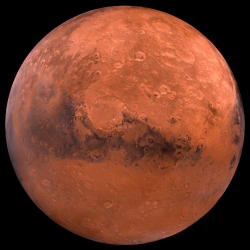
Boron sounds boring, and not just because of the phonetic resemblance. It’s not an element that we use much, other than in some kinds of fiberglass. It’s not toxic or dangerous to humans. Really, the best thing you can say about it is that it can kill cockroaches in its acid form. But on Mars? It’s a sign of life.
Using data from NASA’s Curiosity rover, a team of interdisciplinary scientists has found boron in the Gale Crater. Gale was probably once a lake, and has been the site of multiple discoveries suggesting that life might once have existed on the Red Planet—at least for a little while. In a primitive, microbial form. But before we get too excited about microbes that might have been, let’s talk about what this really means.
Boron isn’t ‘life,’ it just helps form the building blocks
Just to clarify, since some news outlets seem confused, finding boron doesn’t mean that we’ve found life. Mars is, as far as we know, still lifeless. It doesn’t even mean we’ve found definitive proof that life was once there. Boron is simply a sign of life that could have been (or could still be).
You probably don’t think of boron as an essential ingredient for life, because it’s not essential for humans. Plants require it to support their cell walls, but animals don’t seem to need it. Boron isn’t a necessary nutrient for us now, but it does help early life form. Borates, which are basically a boron atom connected to four oxygen atoms, have a fairly unusual ability to stabilize RNA’s backbone to help it stay together.
And RNA is one of the principal ways that genetic information is stored and used in our bodies. If DNA is the manual to building and running the system, then RNA is the person who reads the manual and enacts the instructions. Your DNA gets translated into RNA, which then gets translated into a protein. Proteins are what really carry out a lot of your cellular functions, and without RNA we have no way to do that.
There’s a widespread theory, romantically called RNA World (like water world, but with fewer humans), that says RNA may have been the first kind of genetic code for early life on Earth. Since it’s a single- rather than a double-stranded molecule, it’s less stable than DNA, but it’s able to do something that DNA is not. It can self-replicate. And it can fold up into a kind of pseudo-enzyme, which can help run chemical reactions.
These extra functions make it an attractive candidate for the first genetic molecule. Plenty of viruses today use RNA, not DNA, to survive, and they do alright for themselves. It’s not enough to make a complex biological organism, but it could have been sufficient for early life.
This isn’t the first time we’ve found boron on Mars, but this is still big news
NASA first found evidence of borates on the Martian surface back in 2013, though that wasn’t from a direct sample. It came from meteor MIL 090030, which originated from Mars and landed in Antarctica. That sample was also rich in borates, much like the one from Gale Crater.
Since the borates in this recent study were found on site, researchers can start working on theories as to how the boron might have gotten there. They think the most likely explanation is that Gale Crater was once a lake that experienced cycles of wet and dry seasons, a lot like the ones we see in Death Valley, California. The cycling produces layers of borates alternating with mudstone.
If groundwater trickles back into the same area, the borates can become dissolved in the water and do their RNA-stabilization work. With both RNA and borates suspended in liquid, the two could interact to form early life. And the researchers think that at some point, Gale become a very shallow, but permanent, lake. A small volume of water would mean quite a high concentrations of borates, which would help early RNA molecules to form.
This is still a lot of speculation, albeit highly informed speculation. We don’t know that any of this occurred for sure, and frankly not everyone is even on board with the RNA World hypothesis. We won’t know more until we get further data back from Mars. Until then, rock on, Curiosity.
